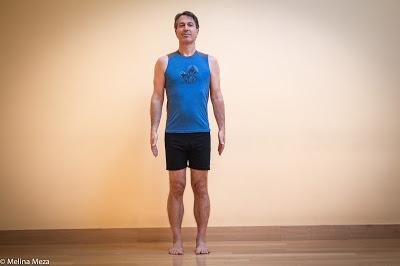 This practice takes you through two steps for exploring the physical body (Annamayakosha), which I described in my post The Physical Body (Annamayakosha), for meaning, openness and freedom. The basic steps are:
This practice takes you through two steps for exploring the physical body (Annamayakosha), which I described in my post The Physical Body (Annamayakosha), for meaning, openness and freedom. The basic steps are:- Becoming aware: Acknowledge what is happening in the body
- Attuning to body sensations: Work with what is happening in the body to deepen self-awareness
1. Take an asana that you can hold for a minimum of 2 – 3 minutes or longer if you are comfortable and wish to spend more time with the exploration.
Consider one of the following postures: Mountain Pose (Tadasana), Legs Up the Wall Pose (Viparita Karani), or Savasana (Relaxation Pose), described at Featured Pose: Relaxation Pose, How to Prepare for and Practice Savasana, and Savasana (Corpse Pose) Variations.
2. Scan your physical body.
Here are a few suggested techniques to choose from. You can also do them all in any sequence that feels comfortable:
Play of Opposites—Explore any similarities or differences between the right and left sides of your body, the front and back of the body or the top half and bottom half of the body.
Contacts—Focus your awareness on any sensations your body is receiving from contacts with the floor, props, position, or clothing.
Body Systems—Using the list of systems in my post LINK or your own list, begin to explore the systems one by one or take a deeper look at a system that is calling for attention or that has been a source of concern. And, yes, I am forever checking in with my digestive system!
As you scan, you may also pick up sensations in the breath or thoughts/feelings from the mind, but for this exercise use any sensations to better understand what is happening in your body. Remember, the key for steps 1 and 2 is to focus your awareness and accept what you find with compassion and without judgment.
Questions to reflect and/or journal on:
- What system(s) in my physical body (Annamayakosha) are changing or presenting challenges?
- How can I adapt my asana practice to work with and/or accept these changes and challenges?
“ Even as the body ages and is able to do less, there are subtleties that reveal themselves, which would be invisible to younger or more athletic bodies. You have to create love and affection for your body, for what it can do for you. Love must be incarcerated in the smallest pore of the skin, the smallest cell of the body, to make them intelligent so they can collaborate with all the other ones, in the big republic of the body.” — from Light on Life: The Yoga Journey to Wholeness, Inner Peace, and Ultimate Freedom
Subscribe to Yoga for Healthy Aging by Email ° Follow Yoga for Healthy Aging on Facebook and Twitter ° To order Yoga for Healthy Aging: A Guide to Lifelong Well-Being, go to Amazon, Shambhala, or Indie Bound
For information on Beth Gibbs' classes and upcoming workshops, see Beth's Classes and Workshops and for information about Beth, ProYoga Therapeutics, and Beth's book and CD, see proyogatherapeutics.com.

